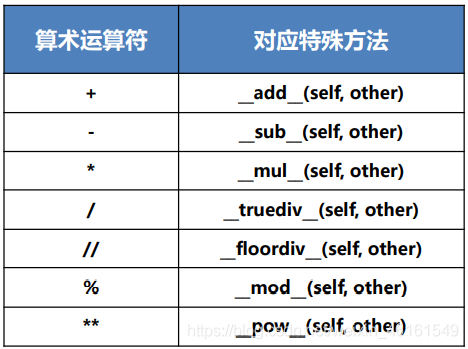运算符重载:为运算符定义方法
所谓重载,就是赋予新的含义同一个运算符可以有不同的功能
让自定义的实例像内建对象一样进行运算符操作让程序简介易读对自定义对象将运算符赋予新的规则 运算符和特殊方法 运算符重载

# @function:运算符重载
# @Description: 一只萤火虫
class MyInteger:
"""
创建一个自定义的整数类型
"""
def __init__(self, data=0):
# 1.如果传入的参数时是整数类型,那么直接赋值
# 2.如果传入的不是整数类型,则判断能够转化成整数,不能转换就赋初值为0
if isinstance(data, int):
self.data = data
elif isinstance(data, str) and data.isdecimal():
self.data = int(data)
else:
self.data = 0
def __add__(self, other):
if isinstance(other, MyInteger):
# 返回当前对象的副本
return MyInteger(self.data + other.data) # 相加的是MyInteger类型
elif isinstance(other, int):
return MyInteger(self.data + other) # 相加的是整型
def __radd__(self, other):
return self.__add__(other)
def __eq__(self, other):
if isinstance(other, MyInteger):
return self.data == other.data
elif isinstance(other, int):
return self.data == other
else:
return False
def __str__(self):
"""
在打印、str(对象)时被自动调用
:return: 用来返回对象的可读字符串形式(适合普通用户阅读)
"""
return str(self.data)
def __repr__(self):
""" 用来将对象转换成供解释器读取的形式,用来阅读对象的底层继承关系及内存地址"""
return "[自定义整数类型的值]:{}\t地址:{}".format(self.data, id(self.data))
def __sub__(self, other):
return MyInteger(self.data - other.data)
def __del__(self):
print("当前对象:" + str(self.data) + "被销毁") # 程序运行完之后自动被销毁
if __name__ == '__main__':
num1 = MyInteger(123)
num2 = MyInteger(321)
num3 = num1 + num2 # 等价于:num3 = num1.__add__(num2)
print("num3 =", num3)
num4 = MyInteger("123")
num5 = num4 + 124 # 在自定义对象的右侧相加整数类型
num6 = 124 + num4 # 在自定义对象的左侧相加整数类型
print("num5 = ", num5, "\t num6 = ", num6)
num7 = MyInteger(1024)
num8 = MyInteger(1024)
print("num7 == num8 :", num7 == num8)

# @function:自定义列表
# @Description:一只萤火虫
class MyList:
def __init__(self, data=None):
self.data = None
if data is None:
self.data = []
else:
self.data = data
def __getitem__(self, index):
# 让本类的对象支持下标访问
if isinstance(index, int):
return self.data[index]
elif type(index) is slice: # 如果参数是切片类型 [10:30:2]
print("切片的起始值:", index.start)
print("切片的结束值:", index.stop)
print("切片的步长:", index.stop)
return self.data[index]
def __setitem__(self, key, value):
self.data[key] = value
def __contains__(self, item):
print("判断传入的", item, "是否在列表元素中")
return self.data.__contains__(item)
def __str__(self):
return str(self.data)
def pop(self, index=-1):
# 默认删除并返回最后一个元素
return self.data.pop(index)
def __delitem__(self, key):
del self.data[key]
def append(self, item):
self.data.append(item)
if __name__ == '__main__':
my_list1 = MyList([item for item in range(10)])
my_list1[1] = 1111
print("显示列表:", my_list1)
print("列表的切片:", my_list1[2:8:2])
print("删除并返回最后一个元素:", my_list1.pop())
del my_list1[1]
print("删除指定下标的元素:", my_list1)
输出结果:
显示列表: [0, 1111, 2, 3, 4, 5, 6, 7, 8, 9]
切片的起始值: 2
切片的结束值: 8
切片的步长: 8
列表的切片: [2, 4, 6]
删除并返回最后一个元素: 9
删除指定下标的元素: [0, 2, 3, 4, 5, 6, 7, 8]
到此这篇关于Python的运算符重载详解的文章就介绍到这了,更多相关Python运算符重载内容请搜索脚本之家以前的文章或继续浏览下面的相关文章希望大家以后多多支持脚本之家!